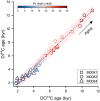Earthquake-enhanced dissolved carbon cycles in ultra-deep ocean sediments
- PMID: 37696798
- PMCID: PMC10495447
- DOI: 10.1038/s41467-023-41116-w
Earthquake-enhanced dissolved carbon cycles in ultra-deep ocean sediments
Abstract
Hadal trenches are unique geological and ecological systems located along subduction zones. Earthquake-triggered turbidites act as efficient transport pathways of organic carbon (OC), yet remineralization and transformation of OC in these systems are not comprehensively understood. Here we measure concentrations and stable- and radiocarbon isotope signatures of dissolved organic and inorganic carbon (DOC, DIC) in the subsurface sediment interstitial water along the Japan Trench axis collected during the IODP Expedition 386. We find accumulation and aging of DOC and DIC in the subsurface sediments, which we interpret as enhanced production of labile dissolved carbon owing to earthquake-triggered turbidites, which supports intensive microbial methanogenesis in the trench sediments. The residual dissolved carbon accumulates in deep subsurface sediments and may continue to fuel the deep biosphere. Tectonic events can therefore enhance carbon accumulation and stimulate carbon transformation in plate convergent trench systems, which may accelerate carbon export into the subduction zones.
© 2023. Springer Nature Limited.
Conflict of interest statement
The authors declare no competing interests.
Figures




References
-
- Plank T, Manning CE. Subducting carbon. Nature. 2019;574:343–352. - PubMed
-
- McHugh CM, et al. Remobilization of surficial slope sediment triggered by the A.D. 2011 Mw 9 Tohoku-Oki earthquake and tsunami along the Japan Trench. Geology. 2016;44:391–394.
-
- Ikehara K, et al. Documenting large earthquakes similar to the 2011 Tohoku-oki earthquake from sediments deposited in the Japan Trench over the past 1500 years. Earth Planet. Sci. Lett. 2016;445:48–56.
Grants and funding
LinkOut - more resources
Full Text Sources

